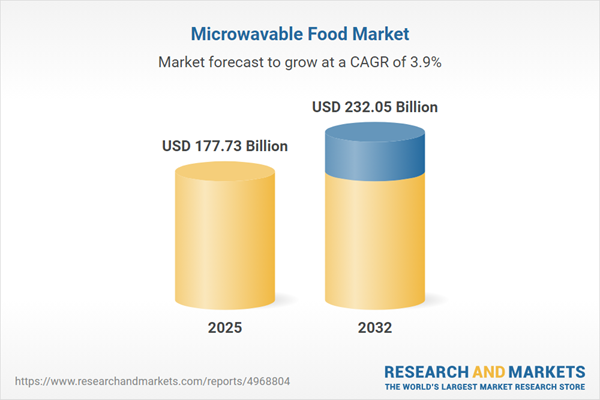Speak directly to the analyst to clarify any post sales queries you may have.
The microwavable food market is rapidly evolving as consumer needs, technology, and product innovation converge. Senior decision-makers require actionable analysis to navigate shifting market conditions, address emerging demands, and identify strategic opportunities for sustainable advantage.
Market Snapshot: Microwavable Food Market Growth and Opportunity
The global microwavable food market grew from USD 171.00 billion in 2024 to USD 177.73 billion in 2025 and is forecasted to reach USD 232.05 billion by 2032, reflecting a CAGR of 3.88%. Evolving consumer habits, particularly an increasing preference for convenience, are fueling industry momentum. Suppliers are responding by streamlining supply chains, aligning with consumer health consciousness, and introducing ready-to-serve products that accommodate diverse eating occasions. Technological advances and ongoing product development, alongside a focus on sustainability, position companies to better compete across global regions and changing lifestyles.
Scope & Segmentation Analysis
This report delivers in-depth coverage of the entire microwavable foods ecosystem, enabling targeted strategic planning for B2B leaders and commercial strategists.
- Product Types: Frozen entrées, popular snacks like nachos and popcorn, a variety of soups, and vegetable options packaged for microwave safety, meeting the eating needs of both single-person and family consumers.
- Packaging Types: Resealable and tear-open pouches, bowls crafted from paper and plastic materials, as well as disposable cups and trays, each designed for user safety and product preservation.
- Distribution Channels: Retailing via convenience stores, online platforms, direct-to-consumer channels, third-party e-commerce, and specialty stores, increasing accessibility and expanding end-user reach.
- Regional Coverage: Comprehensive analysis of the Americas, Europe, Middle East & Africa, and Asia-Pacific, with attention to major consumer markets such as the United States, China, Brazil, Germany, India, Japan, South Africa, and Australia.
- Key Companies Covered: Market insight into Conagra Brands, Nestlé S.A., The Kraft Heinz Company, General Mills, Campbell Soup Company, McCain Foods, Tyson Foods, B&G Foods, Amy’s Kitchen, and The Hain Celestial Group.
- Technological Trends: Novel barrier films and intelligent venting, plant-based protein and nutrient-fortified ingredients, and AI-powered product recommendation engines for greater personalization and user engagement.
Key Takeaways: Strategic Insights for Decision-Makers
- Convenience-driven demand and consumer focus on wellness expand product portfolios, catering to family households and the rising number of single-person buyers.
- Packaging improvements and advances in food science contribute to nutrient retention, better flavor, and growing trust in microwavable options.
- Sustainability initiatives, including eco-friendly packaging and reduced use of single-use plastics, are reshaping design decisions and influencing purchasing habits.
- Personalized solutions, such as subscription-based meals and AI-driven choices, are strengthening customer engagement and fostering loyalty in the microwavable food market.
- Regional nuances—Europe’s clean-label preference, the Americas’ heightened convenience needs, and tailored flavors in Asia-Pacific—require adaptive, local strategies.
- Collaboration with research bodies, technology startups, and ingredient suppliers accelerates innovation cycles and supports the development of differentiated products for targeted markets.
Tariff Impact: Navigating U.S. Trade Policy Changes
Recent changes in U.S. trade policy and tariffs on raw materials have encouraged sector participants to adjust procurement and supply strategies. Companies now increasingly emphasize domestic sourcing and strategic partnerships with local farmers and packaging suppliers to alleviate tariff exposure. Enhanced inventory controls, streamlined manufacturing, and formula adaptation are also being adopted to manage costs while maintaining product standards. Improved coordination with retail partners further supports industry adaptation to evolving cost environments and market pressures.
Methodology & Data Sources
This report applies a mixed-methods research design, incorporating executive and technical expert interviews, targeted consumer surveys, and industry-specific case studies. Insights are verified through leading publications, regulatory documentation, market intelligence platforms, and sustainability assessments, using scenario analysis for added rigor and reliability.
Why This Report Matters for the Microwavable Food Market
- Enables effective market entry strategies, prioritization of new product investment, and the deployment of resources tailored to specific regional dynamics.
- Offers comprehensive segment insights and technology analysis to inform sustainable, profitable growth in a competitive environment.
- Guides tariff risk mitigation efforts and supports the development of resilient global supply chains amid regulatory and market shifts.
Conclusion
Success in the microwavable food market depends on proactive innovation, prioritizing sustainability, and adapting quickly to consumer expectations. This analysis equips leaders with actionable frameworks to seize opportunities and sustain growth.
Additional Product Information:
- Purchase of this report includes 1 year online access with quarterly updates.
- This report can be updated on request. Please contact our Customer Experience team using the Ask a Question widget on our website.
Table of Contents
3. Executive Summary
4. Market Overview
7. Cumulative Impact of Artificial Intelligence 2025
List of Figures
Samples

LOADING...
Companies Mentioned
The key companies profiled in this Microwavable Food market report include:- Conagra Brands, Inc.
- Nestlé S.A.
- The Kraft Heinz Company
- General Mills, Inc.
- Campbell Soup Company
- McCain Foods Limited
- Tyson Foods, Inc.
- B&G Foods, Inc.
- Amy’s Kitchen, Inc.
- The Hain Celestial Group, Inc.
Table Information
| Report Attribute | Details |
|---|---|
| No. of Pages | 197 |
| Published | October 2025 |
| Forecast Period | 2025 - 2032 |
| Estimated Market Value ( USD | $ 177.73 Billion |
| Forecasted Market Value ( USD | $ 232.05 Billion |
| Compound Annual Growth Rate | 3.8% |
| Regions Covered | Global |
| No. of Companies Mentioned | 11 |









